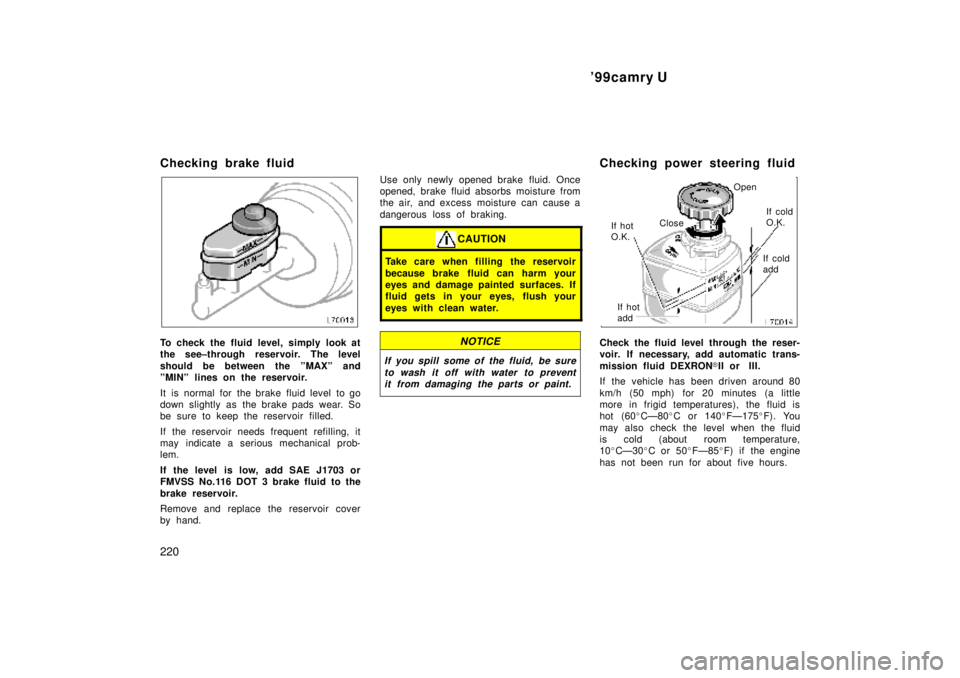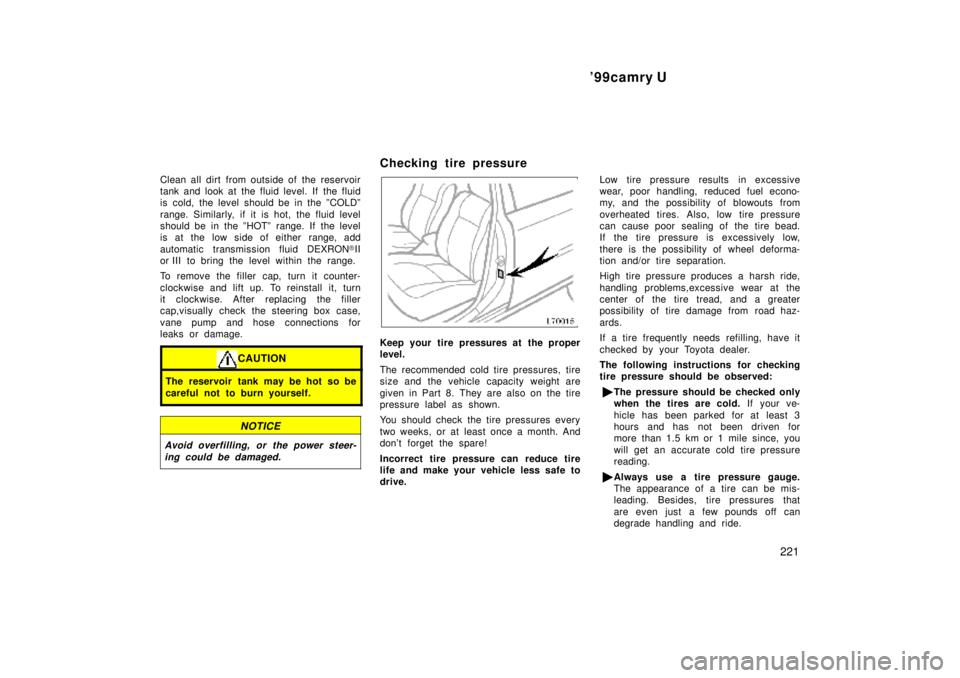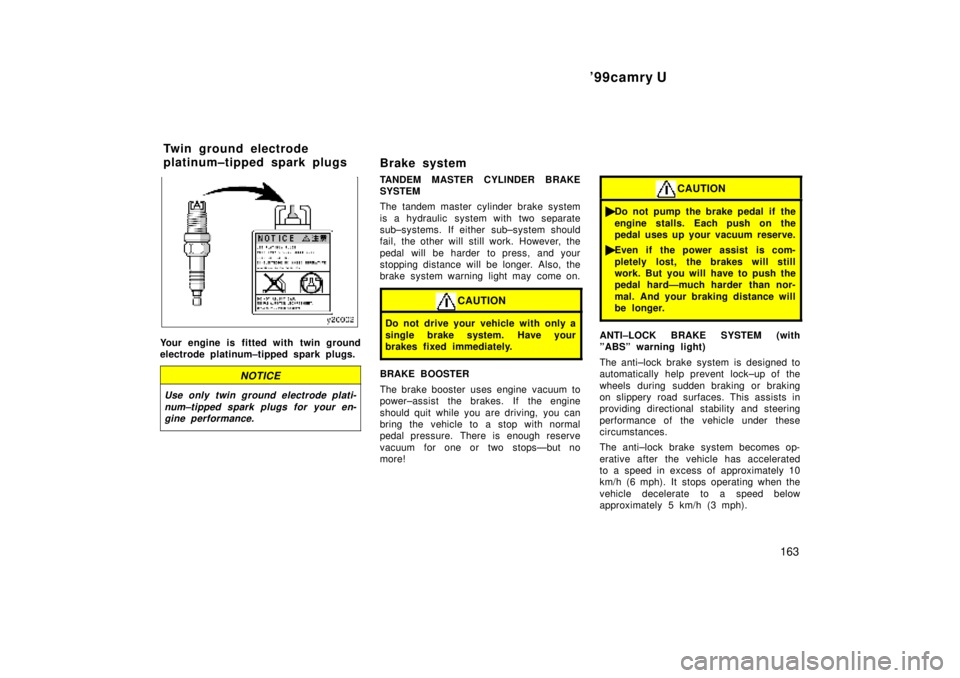Page 934 of 4770

'99camry U
220
Checking brake fluid
To check the fluid level, simply look at
the see±through reservoir. The level
should be between the ºMAXº and
ºMINº lines on the reservoir.
It is normal for the brake fluid level to go
down slightly as the brake pads wear. So
be sure to keep the reservoir filled.
If the reservoir needs frequent refilling, it
may indicate a serious mechanical prob-
lem.
If the level is low, add SAE J1703 or
FMVSS No.116 DOT 3 brake fluid to the
brake reservoir.
Remove and replace the reservoir cover
by hand.Use only newly opened brake fluid. Once
opened, brake fluid absorbs moisture from
the air, and excess moisture can cause a
dangerous loss of braking.
CAUTION
Take care when filling the reservoir
because brake fluid can harm your
eyes and damage painted surfaces. If
fluid gets in your eyes, flush your
eyes with clean water.
NOTICE
If you spill some of the fluid, be sure
to wash it off with water to prevent
it from damaging the parts or paint.
Checking power steering fluid
CloseOpen
If hot
O.K.If cold
O.K.
If hot
addIf cold
add
Check the fluid level through the reser-
voir. If necessary, add automatic trans-
mission fluid DEXRON�II or III.
If the vehicle has been driven around 80
km/h (50 mph) for 20 minutes (a little
more in frigid temperatures), the fluid is
hot (60�CÐ80�C or 140�FÐ175�F). You
may also check the level when the fluid
is cold (about room temperature,
10�CÐ30�C or 50�FÐ85�F) if the engine
has not been run for about five hours.
Page 935 of 4770

'99camry U
221
Clean all dirt from outside of the reservoir
tank and look at the fluid level. If the fluid
is cold, the level should be in the ºCOLDº
range. Similarly, if it is hot, the fluid level
should be in the ºHOTº range. If the level
is at the low side of either range, add
automatic transmission fluid DEXRON�II
or III to bring the level within the range.
To remove the filler cap, turn it counter-
clockwise and lift up. To reinstall it, turn
it clockwise. After replacing the filler
cap,visually check the steering box case,
vane pump and hose connections for
leaks or damage.
CAUTION
The reservoir tank may be hot so be
careful not to burn yourself.
NOTICE
Avoid overfilling, or the power steer-
ing could be damaged.
Checking tire pressure
Keep your tire pressures at the proper
level.
The recommended cold tire pressures, tire
size and the vehicle capacity weight are
given in Part 8. They are also on the tire
pressure label as shown.
You should check the tire pressures every
two weeks, or at least once a month. And
don't forget the spare!
Incorrect tire pressure can reduce tire
life and make your vehicle less safe to
drive.Low tire pressure results in excessive
wear, poor handling, reduced fuel econo-
my, and the possibility of blowouts from
overheated tires. Also, low tire pressure
can cause poor sealing of the tire bead.
If the tire pressure is excessively low,
there is the possibility of wheel deforma-
tion and/or tire separation.
High tire pressure produces a harsh ride,
handling problems,excessive wear at the
center of the tire tread, and a greater
possibility of tire damage from road haz-
ards.
If a tire frequently needs refilling, have it
checked by your Toyota dealer.
The following instructions for checking
tire pressure should be observed:
�The pressure should be checked only
when the tires are cold. If your ve-
hicle has been parked for at least 3
hours and has not been driven for
more than 1.5 km or 1 mile since, you
will get an accurate cold tire pressure
reading.
�Always use a tire pressure gauge.
The appearance of a tire can be mis-
leading. Besides, tire pressures that
are even just a few pounds off can
degrade handling and ride.
Page 959 of 4770

'99camry U
163
Your engine is fitted with twin ground
electrode platinum±tipped spark plugs.
NOTICE
Use only twin ground electrode plati-
num±tipped spark plugs for your en-
gine performance.
Brake system
TANDEM MASTER CYLINDER BRAKE
SYSTEM
The tandem master cylinder brake system
is a hydraulic system with two separate
sub±systems. If either sub±system should
fail, the other will still work. However, the
pedal will be harder to press, and your
stopping distance will be longer. Also, the
brake system warning light may come on.
CAUTION
Do not drive your vehicle with only a
single brake system. Have your
brakes fixed immediately.
BRAKE BOOSTER
The brake booster uses engine vacuum to
power±assist the brakes. If the engine
should quit while you are driving, you can
bring the vehicle to a stop with normal
pedal pressure. There is enough reserve
vacuum for one or two stopsÐbut no
more!
CAUTION
�Do not pump the brake pedal if the
engine stalls. Each push on the
pedal uses up your vacuum reserve.
�Even if the power assist is com-
pletely lost, the brakes will still
work. But you will have to push the
pedal hardÐmuch harder than nor-
mal. And your braking distance will
be longer.
ANTI±LOCK BRAKE SYSTEM (with
ºABSº warning light)
The anti±lock brake system is designed to
automatically help prevent lock±up of the
wheels during sudden braking or braking
on slippery road surfaces. This assists in
providing directional stability and steering
performance of the vehicle under these
circumstances.
The anti±lock brake system becomes op-
erative after the vehicle has accelerated
to a speed in excess of approximately 10
km/h (6 mph). It stops operating when the
vehicle decelerate to a speed below
approximately 5 km/h (3 mph).
Twin ground electrode
platinum±tipped spark plugs
Page 975 of 4770
'99camry U
179
CAUTION
Never turn off the engine to coast
down hills. Your power steering and
brake booster will not function with-
out the engine running. Also, the
emission control system operates
properly only when the engine is run-
ning.
Page 1002 of 4770

'99camry U
206
IN THE ENGINE COMPARTMENT
Items listed below should be checked
from time to time, e.g. each time when
refueling.
Washer fluid
Make sure there is sufficient fluid in the
tank. See Chapter 7±3 for additional in-
formation.
Engine coolant level
Make sure the coolant level is between
the ºFULLº and ºLOWº lines on the see±
through reservoir when the engine is cold.
See Chapter 7±2 for additional information.
Battery electrolyte level
Make sure the electrolyte level of all bat-
tery cells is between upper and lower lev-
el lines on the case. Add only distilled
water when replenishing. See Chapter 7±3
for additional information.
Brake fluid level
Make sure the brake fluid level is correct.
See Chapter 7±2 for additional information.
Engine oil level
Check the level on the dipstick with the
engine turned off and the vehicle parked
on a level spot. See Chapter 7±2 for addi-
tional information.Power steering fluid level
Check the level through the reservoir. The
level should be in the ºHOTº or ºCOLDº
range depending on the fluid temperature.
See Chapter 7±2 for additional information.
Exhaust system
If you notice any change in the sound of
the exhaust or smell exhaust fumes, have
the cause located and corrected immedi-
ately. (See engine exhaust cautions in
Part 2.)Be on the alert for changes in perfor-
mance, sounds, and visual tip±offs that
indicate service is needed. Some impor-
tant clues are as follows:
�Engine missing, stumbling, or pinging
�Appreciable loss of power
�Strange engine noises
�A leak under the vehicle (however, wa-
ter dripping from the air conditioning
after use is normal.)
�Change in exhaust sound (This may
indicate a dangerous carbon monoxide
leak. Drive with the windows open and
have the exhaust system checked im-
mediately.)
�Flat±looking tire; excessive tire squeal
when cornering; uneven tire wear
�Vehicle pulls to one side when driving
straight on a level road
�Strange noises related to suspension
movement
�Loss of brake effectiveness; spongy
feeling brake or clutch pedal;pedal al-
most touches floor; vehicle pulls to one
side when braking
�Engine coolant temperature continually
higher than normal
Does your vehicle need
repairing?
Page 1006 of 4770

'99camry U
240
Engine
Model:
5S±FE and 1MZ±FE
Type:
5S±FE engine
4 cylinder in line, 4 cycle, gasoline
1MZ±FE engine
6 cylinder V type 4 cycle, gasoline
Bore and stroke, mm (in.):
5S±FE engine
87.0 � 91.0 (3.43 � 3.58)
1MZ±FE engine
87.5 � 83.0 (3.44 � 3.27)
Displacement, cm
3 (cu. in.):
5S±FE engine
2164 (132.0)
1MZ±FE engine
2995 (182.8)
Fuel
Fuel type:
5S±FE engine
Unleaded gasoline, Octane Rating 87
(Research Octane Number 91) or higher
1MZ±FE engine
Unleaded gasoline, Octane Rating 87
(Research Octane Number 91) or higher.
For improved vehicle performance, the
use of premium unleaded gasoline with
an Octane Rating of 91 (Research Oc-
tane Number 96) or higher is recom-
mended.
Fuel tank capacity, L (gal., Imp. gal.):
70 (18.5, 15.4)
Service specifications
ENGINE
Valve clearance (engine cold), mm (in.):
5S±FE engine
Intake 0.19Ð0.29 (0.007Ð0.011)
Exhaust 0.28Ð0.38 (0.011Ð0.015)
1MZ±FE engine
Intake 0.15Ð0.25 (0.006Ð0.010)
Exhaust 0.25Ð0.35 (0.010Ð0.014)
Spark plug type:
DENSO PK20TR11
NGK BKR6EKPB11
Spark plug gap, mm(in.):
1.1 (0.043)
Drive belt tension measured with Borroughs
drive belt tension gauge No.BT±33±73F
(used belt), Ibf:
5S±FE engine
With air conditioning
Generator belt 130�10
Power steering pump belt 80�20
Without air conditioning
Generator belt 65�20
Power steering pump belt 80�20
1MZ±FE engine 115�20
Page 1008 of 4770
'99camry U
242
5S±FE engine
Automatic transmission
Fluid capacity (drain and refill),
L (qt., Imp. qt.):
Up to 2.5 (2.6, 2.2)
Fluid type:
Automatic transmission fluid D±ll or
DEXRON�IIl (DEXRON�II)
Differential
Fluid capacity L (qt., Imp. qt.):
1.6 (1.7, 1.4)
Fluid type:
Automatic transmission fluid D±II or
DEXRON�III (DEXRON�II)
BRAKES
Minimum pedal clearance when depressed
with the pressure of 490 N (50 kgf, 110 lbf)
with the engine running, mm (in.):
70 (2.8)
Pedal freeplay, mm (in.):
1Ð6 (0.04Ð0.24)
Pad wear limit, mm (in.):
1.0 (0.04)
Lining wear limit, mm (in.):
1.0 (0.04)
Parking brake adjustment when pulled with
the force of 196 N (20 kgf, 44 lbf):
5Ð8 clicksFluid type:
SAE J1703 or FMVSS No.116 DOT 3
STEERING
Wheel freeplay:
Less than 30 mm (1.2 in.)
Power steering fluid type:
Automatic transmission fluid DEXRON�II
or III
Page 1019 of 4770
1
GENERAL 1999 FEATURES
148BE16
Corolla
Right Side Front
Airbag SensorInflator and Bag for
Front Passenger
(Above the Glove Box)
Airbag Sensor Assembly Inflator and Bag for Driver
(In Steering Wheel Pad) Left Side Front
Airbag Sensor
SRS Warning Light
160GE04
Front Airbag
Sensor (RH)
Battery
Front Airbag
Sensor (LH)
DC-DC
Converter
Back-Up
Power
Source
CPU
Airbag
Sensor
Safing
Sensor
Drive
Circuit
Drive
Circuit
Drive
Circuit
Drive
Circuit
SRS Warning Light
DLC1
Squib (For Driver)
Initiator
(For Front
Passenger)
Spiral Cable
To Seat Belt
Pretensioner Airbag Sensor AssemblyDLC3
5
2. Layout of Components
The major function parts of the airbag systems are shown below.
3. Wiring DIagram